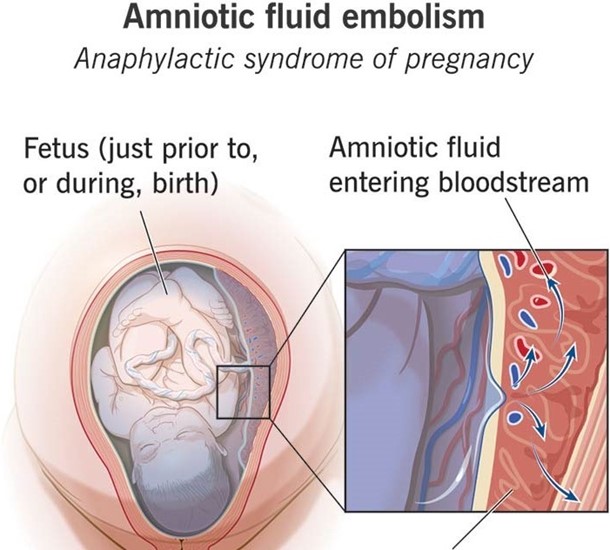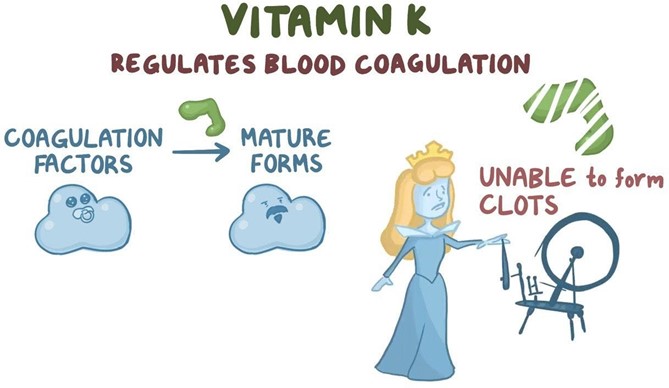Following a normal spontaneous vaginal delivery (NSVD), a 28 year old G3 now P3 mother develops sudden onset shortness of breath, hypoxia and cyanosis. The delivery room nurse quickly recognizes these symptoms as possible:
Select one:
Manifestations of uteroplacental insufficiency.
Manifestations of prolapsed cord.
Manifestations of anaphylactoid syndrome of pregnancy.
Manifestations of an acute asthmatic episode.
The Correct Answer is C
Choice A Reason: Manifestations of uteroplacental insufficiency. This is an incorrect answer that describes a different condition that affects the fetus, not the mother. Uteroplacental insufficiency is a condition where the placenta fails to deliver adequate oxygen and nutrients to the fetus, which can result in fetal growth restriction, distress, or demise. Uteroplacental insufficiency does not cause shortness of breath, hypoxia, or cyanosis in the mother.
Choice B Reason: Manifestations of prolapsed cord. This is an incorrect answer that refers to another condition that affects the fetus, not the mother. Prolapsed cord is a condition where the umbilical cord slips through the cervix before the baby and becomes compressed by the fetal head, which can reduce oxygen flow to the fetus. Prolapsed cord does not cause shortness of breath, hypoxia, or cyanosis in the mother.
Choice C Reason: Manifestations of anaphylactoid syndrome of pregnancy. This is because anaphylactoid syndrome of pregnancy, also known as amniotic fluid embolism, is a rare and fatal condition where amniotic fluid enters into the maternal bloodstream and causes an allergic reaction, which can lead to respiratory failure, cardiac arrest, coagulopathy, and coma. Anaphylactoid syndrome of pregnancy can occur during or after labor and delivery, especially in cases of NSVD, multiparity, advanced maternal age, or placental abruption.
Choice D Reason: Manifestations of an acute asthmatic episode. This is an incorrect answer that assumes that the mother has a history of asthma or an allergic trigger. Asthma is a chronic inflammatory disorder of the airways that causes wheezing, coughing, chest tightness, and dyspnea. Asthma can be exacerbated by pregnancy or labor, but it is not a common cause of sudden onset respiratory distress in the postpartum period.

Nursing Test Bank
Naxlex Comprehensive Predictor Exams
Related Questions
Correct Answer is D
Explanation
Choice A Reason: Vitamin K will increase erythropoiesis. This is an incorrect statement that confuses vitamin K with erythropoietin. Erythropoietin is a hormone that stimulates red blood cell production in the bone marrow. Vitamin K does not affect erythropoiesis.
Choice B Reason: Vitamin K will enhance bilirubin breakdown. This is an incorrect statement that confuses vitamin K with phototherapy. Phototherapy is a treatment that exposes the newborn's skin to light, which converts bilirubin into water-soluble forms that can be excreted by the liver and kidneys. Bilirubin is a yellow pigment that results from the breakdown of red blood cells. High levels of bilirubin can cause jaundice and brain damage in newborns. Vitamin K does not affect bilirubin metabolism.
Choice C Reason: Vitamin K will stop Rh sensitization. This is an incorrect statement that confuses vitamin K with Rh immune globulin. Rh immune globulin is an injection given to Rh-negative mothers who deliver Rh-positive babies, to prevent them from developing antibodies against Rh-positive blood cells in future pregnancies. Rh sensitization is a condition where the mother's immune system atacks the baby's blood cells, causing hemolytic disease of the newborn. Vitamin K does not affect Rh sensitization.
Choice D Reason: Vitamin K will promote blood clotting ability. This is a correct statement that explains the rationale for administering vitamin K as prophylaxis to newborns. Vitamin K is essential for the synthesis of clotting factors in the liver. Newborns have low levels of vitamin K at birth due to poor placental transfer and lack of intestinal bacteria that produce vitamin K. Therefore, they are at risk of bleeding disorders such as hemorrhagic disease of the newborn.

Correct Answer is A
Explanation
Choice A Reason: "Our baby's newborn rash is from this syndrome." This is because this statement by a parent indicates that additional teaching is required, as it shows a misunderstanding or confusion about FAS and its manifestations. FAS is a condition that occurs when a woman consumes alcohol during pregnancy, which can affect the development and function of various organs and systems in the fetus and child. FAS can cause physical, behavioral, and cognitive problems such as facial abnormalities, growth retardation, learning difficulties, and atention deficits. FAS does not cause newborn rash, which is a common and benign condition that affects many newborns regardless of maternal alcohol intake. Newborn rash is also known as erythema toxicum neonatorum or baby acne, which is characterized by small red bumps or pustules on the face, chest, or back that usually disappear within a few weeks.
Choice B Reason: "His face looks like it does due to this problem." This is a correct answer that indicates adequate understanding of FAS and its features. Facial abnormalities are one of the characteristic signs of FAS, which include small eye openings, thin upper lip, flat nasal bridge, and smooth philtrum (the groove between the nose and upper lip).
Choice C Reason: "He can show signs of withdrawal from alcohol exposure like jiteriness, sweating, hyper reflexes, poor feeding and not sleeping well." This is a correct answer that indicates adequate understanding of FAS and its complications. Signs of withdrawal are possible effects of FAS, which occur when the fetus or newborn is exposed to alcohol in utero or through breast milk, which can cause neurotoxicity and dependency. Signs of withdrawal can include jiteriness, sweating, hyper reflexes, poor feeding, and not sleeping well, as well as irritability, seizures, or tremors.
Choice D Reason: "He is at risk of having intellectual disabilities, so we will need to get extra services to support him." This is a correct answer that indicates adequate understanding of FAS and its implications. Intellectual disabilities are potential outcomes of FAS, which affect the cognitive development and function of the child. Intellectual disabilities can cause problems with memory, Reasoning, language, and social skills. Extra services and support may be needed to help the child achieve their optimal potential and quality of life.
Whether you are a student looking to ace your exams or a practicing nurse seeking to enhance your expertise , our nursing education contents will empower you with the confidence and competence to make a difference in the lives of patients and become a respected leader in the healthcare field.
Visit Naxlex, invest in your future and unlock endless possibilities with our unparalleled nursing education contents today
Report Wrong Answer on the Current Question
Do you disagree with the answer? If yes, what is your expected answer? Explain.
Kindly be descriptive with the issue you are facing.
